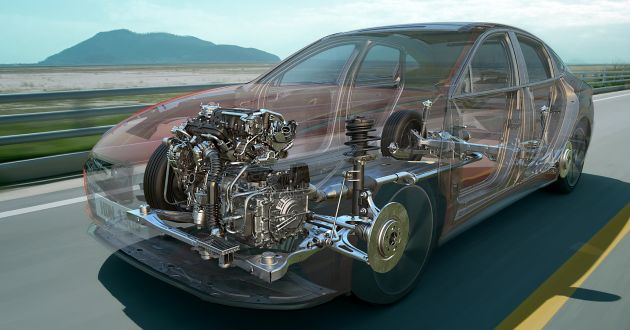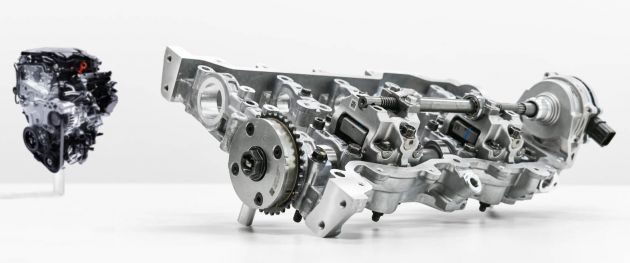Hyundai Motor Group has unveiled its new Continuously Variable Valve Duration (CVVD) technology, which will first be applied on the Smartstream G 1.6 litre turbocharged four-cylinder T-GDi that is available for the latest Sonata. Future Hyundai and Kia models will also benefit from the engine technology, with more information on the matter set to be released later on.
According to Hyundai, CVVD regulates the duration of valve opening and closing according to driving conditions, allowing for a 4% increase in performance, 5% improvement in fuel efficiency, and 12% less emissions.
In typical, four-stroke internal combustion engines, the variable valve control system adjusts the timing of the valve’s opening and closing (as in Continuously Variable Valve Timing or CVVT), or by controlling the volume of air admitted by adjusting the depth of the opening (as in Continuously Variable Valve Lift or CVVL).
However, these setups are unable to regulate valve duration, as the valve’s closing timing is under the authority of the opening timing, making it unresponsive to changing driving situations. Hyundai’s CVVD rectifies this by adjusting how long a valve stays open.
In practice, when the vehicle is driving at a constant speed and requires little engine power, CVVD opens the intake valve from the middle to end of the compression stroke. This is meant to improve fuel efficiency by reducing the resistance caused by compression.
On the other hand, when acceleration or higher engine output is needed, the intake valve is closed at the beginning of the compression stroke to maximize the amount of air used for combustion to improve torque.
The solution appears to applicable for the intake valves only, with the camshaft being moved slightly off centre to control the duration the valves are open for. This also has an effect on valve opening and closing timings, with the maximum opening point remaining the same during a combustion cycle.
Controlling valve duration has been done in the past, as FreeValve demonstrated with its complex Qamfree engine, where a pneumatic-hydraulic-electronic actuator replaced the traditional camshaft-based method of controlling valve operation. However, Hyundai’s approach retains the camshaft, and it claims its CVVD technology is a world first.
Focusing on the Smartstream G 1.6 litre unit, the mill churns out 180 hp and 264 Nm of torque. Aside from CVVD, the engine also comes equipped with a Low-Pressure Exhaust Gas Recirculation (LP EGR). This returns some of the gas burnt by the engine back to the combustion chamber, producing a cooling effect and reducing the emission of nitrogen oxides.
The system also redirects the burnt emission gas to the front of the turbocharger compressor, rather than the intake system, for better efficiency under the high load conditions.
Meanwhile, low-friction parts help reduce engine friction by 34%, and an Integrated Thermal Management System quickly heats or cools the engine to its optimal operating temperature. The engine also benefits from a stronger direct injection system that operates at 350 bar, which is more than the 250 bar of the previous T-GDi engine.
Looking to sell your car? Sell it with Carro.













This Korea tech similar to the DVVT engine in my 2003 Perodua Kembara. Nothing new here.
Well Koreans are good at taking something from others and renaming as their own. That itself is nothing new here.
guess you didnt read the article then
Just like CVT.
It exist long long time ago…………………………………..
Just like CVT.
It exist long long time ago……………..
Can Malaysians read? This is variable valve duration not variable valve timing!
Duration = timing
DVVT is basically a VVTi. Just another variable valve timing system. Similar to Hyundai’s CVVT
valve timing and valve duration are not the same thing, albeit some correlation there
Too bad the engine is designed in Europe and not Korea.
Yawn….Next
But Hyundai got lots of recalls like engine fire risk, airbags and other many parts. For more info, if you buy Hyundai, will be more riskier to the consumers. Especially, This will also have lots of problems about this CVVD Hyundai Engine in the future
There are so many gaps in the internal combustion
Great to hear this
Korean please stop the crap. Rover did this 20 years ago with the Rover K series VVC engine. Variable valve duration control.
world 1st? I thought honda already did it with their vtec turbo?
Its Honda VVEL tech
Sounds like Toyota’s Atkinson Cycle engine with turbocharger.
There’s a compromise.. the engine will be less durable due to added complications.